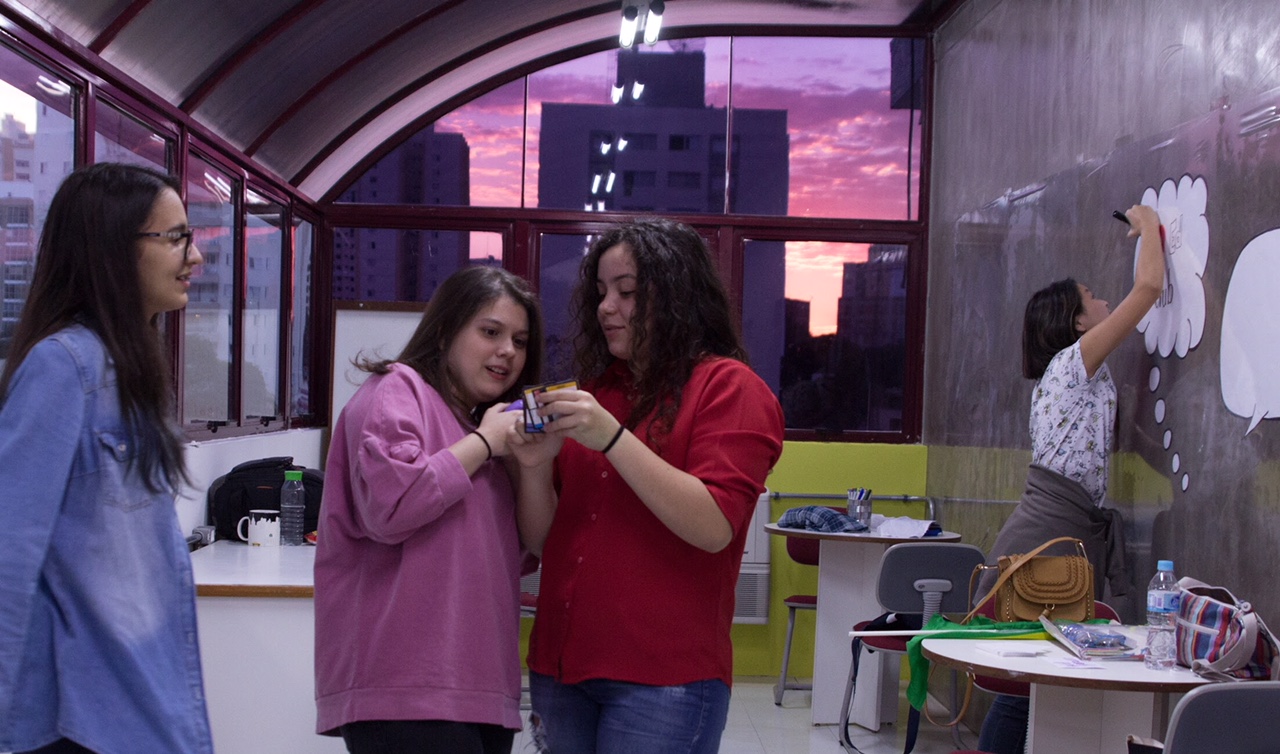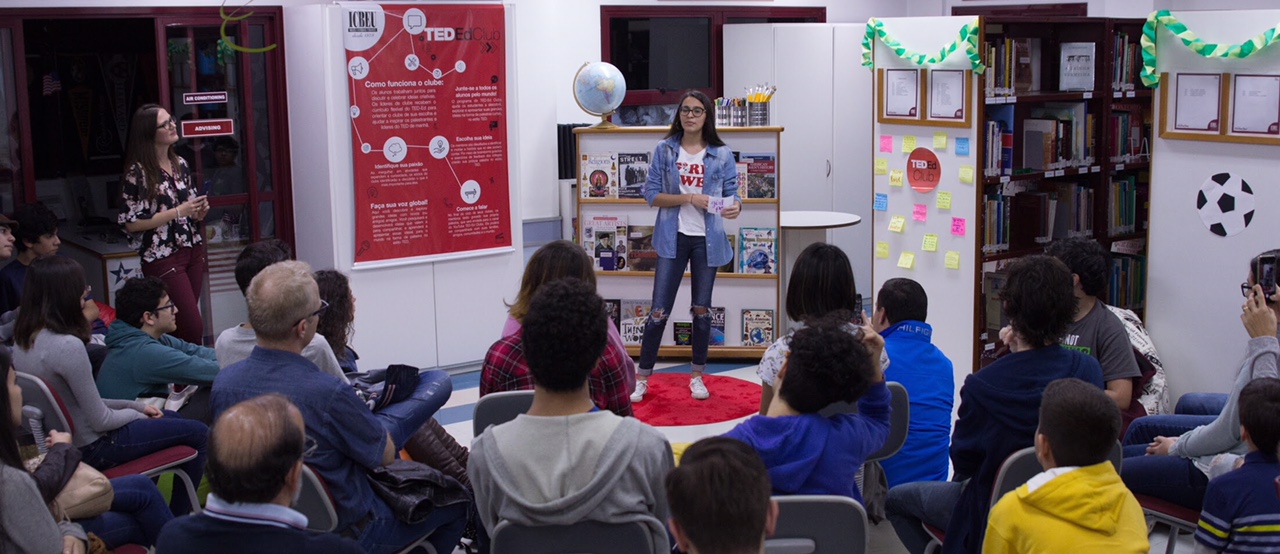 |
| photo by Davi Naves |
My Maker Monday posts usually share practical, hands-on STEAM (Science, Technology, Engineering, Arts, Math) activities that can be used in the English language classroom and beyond. To end the semester, I'll share about a different kind of making--creating a safe space for young people to develop as thinkers, collaborators, and public speakers.
Perhaps the most exciting part of this past semester, and definitely one of the most memorable of my career, has been leading a TED-Ed Club. These clubs are gatherings of school aged students around the world, ages 8-18, meeting to celebrate great ideas. TED stands for Technology, Entertainment, and Design, and their short, filmed talks on a multitude of topics in all fields of study are hugely popular all over the world, especially in education.
The aim of TED-Ed Clubs is to give students a voice--to help them identify their passions, choose an idea that's "worth spreading," and then develop a presentation about that idea in the form of a TED-like talk, which is filmed and can be shared with the world. These clubs are officially recognized by TED-Ed, and follow a flexible curriculum that seeks to encourage creativity and innovation in choosing "an idea worth spreading," and build critical thinking, communication and presentation skills as students plan how to present their idea. Students also learn how to collaborate with peers and give feedback, and are encouraged to be in charge of their own learning. It's about empowering students with essential life skills and giving them a voice. All in all, I think it makes better people. What more important thing could be made in a maker space?
In seeking to embrace the maker movement and develop global citizens, a few colleagues and I worked to bring a TED-Ed Club to the bi-national center where we teach. Knowing that the aim was to develop a presentation to share with the world, preferably in English, in order to reach more people, we invited students in the B2 (upper intermediate) level and above, in the appropriate age range, to join the club.
After some delays and setbacks, this March, at the start of the school year, we finally launched the club, and I was thrilled to see a handful of my former students participating. Not having done this before, I pretty much stuck to the TED-Ed curriculum, which included videos with clips of TED Talks, guiding questions, suggested activities, and an idea book for students to work with throughout the semester.
My main focus was creating a safe space for students to be fully themselves while they explored their ideas. That meant that the strict "no Portuguese" rule that we have in English classes was dropped. We operated in English, and I helped students develop their presentations in English, but there were times when they just needed to speak or write in their native language to work out some ideas. We also met, not in a classroom, but in the maker space, where students were encouraged to use anything they could find to bring their ideas to life. They were also given the freedom to be responsible for their own learning and use large chunks of our meeting time as they pleased, working alone or in groups. Sometimes that meant searching for information online, choosing a TED Talk to watch and discuss, or writing on the wall or filling it up with sticky-notes expressing things that were on their heart.
Other times it meant playing a game or just goofing around with friends to blow off steam. I brought homemade cookies on occasion, but I think one of our favorite snacks was making dirt dessert. It involved smashing cookies into "dirt," to mix with chocolate pudding and top with gummy worms. The smashing cookies part was especially attractive to students who deal with a lot of stress throughout the week. The moment I stepped out of the maker space to tell the librarian we would be making a bit of noise, a student smashed an unopened package of cookies on the table, causing an epic cookie explosion that we were laughing about for a long time! I had forgotten to bring extra baggies or equipment to crush the cookies with, and so we had to improvise and innovate, while taking responsibility for the mess--all important life skills.
I always started the group with a warm-up, often longer than the ones I bring to class, to allow students to unwind from the week and express themselves in a different way. Most of these warm-ups were games from my special collection. I would often connect a skill learned in the game to a skill we were working on in our club explorations. One memorable one was Snake Oil, and combining passions to innovate, which brought a breakthrough to those who were stuck or felt like they had no ideas. Another was Reverse Charades, and a discussion on the challenge of getting ideas across, and the power of body language. On the day of their presentations, we played Taboo, and I reminded them that if they forget a word in English, they can improvise, and navigate around it using other words just like in the game. Games like these, besides being ridiculously fun, develop important soft skills like communication and creative thinking. Sometimes the word you are trying to get your teammates to guess seems so obvious to you, but you find that it's not as obvious to them, and you have to try a different approach to get the idea across.
One element of TED-Ed Clubs that we missed out on to some degree was being able to connect with other clubs around the world to share ideas. It's common to have a connect week and make video calls with other clubs, but nothing fit our schedule this time around. One opportunity that we were able to take, however, was using the web app Sprout, developed for TED-Ed Clubs by a TED Innovator. It allows students to share their ideas with people around the world and get feedback in a safe way, and I feel it really benefited our group.
Collaboration and feedback are essential for this kind of endeavor, whether it comes from halfway around the world, or from a fellow classmate. We worked to create an environment where kids felt safe giving and getting constructive feedback from one another. And students who chose not to give a talk this time around were there to help and encourage their peers. We even had a resident artist!
The hardest part for the kids was getting up in front of the group and practicing their speeches (working their way up to doing it in front of a camera and an audience!) I reminded the students that it was their choice how and when to share their ideas--no one was forcing a microphone on them! A few decided toward the end of the semester to opt out of giving a talk, and I assured them it was fine. Some decided to only film their talk and not do it in front of an audience, which was also fine. I think, though, after seeing their peers present, and seeing how well it went, they will be more motivated to push themselves further next time around. But it's important to meet people where they're at, in order to get them to step up to the next level.
All in all, the final presentations were a huge success. Parents and friends and other teachers came to support the speakers. A few students decorated the library by setting up a background with interesting books and putting up some of their favorite inspiring sticky notes. And we managed to get a classic red circle in the style of TED for the speakers to stand on! As the guests arrived, I pulled the kids aside a few minutes before start time to do some quick, fun theater warm-ups that I had learned from my improv days, to redirect energy and give focus. A few minutes later, in my worst gringa accent ever (especially bad this time because the same anxiety the speakers faced hit me only at the last moment), I welcomed the crowd in Portuguese and explained a bit about TED-Ed Clubs. And then the students presenting got up one by one and gave a brief, but powerful talk that brought tears and goosebumps and lots of applause. It was such an honor to be part of making these young voices heard.
 |
| photo by Davi Naves |
 |
| photo by Davi Naves |
There are always things we could improve on, and, if TED-Ed approves us for next semester, I look forward to making things even bigger and better. But this was a huge first step for these young people, standing on that red carpet and sharing ideas they are passionate about with our local community and with the world, all in a foreign language. I'm incredibly proud of them all--those who presented, and those who didn't--for believing that their ideas are worth spreading, and for stepping out and taking a risk to talk about things they are passionate about. I love the little community we formed, which was a safe place for young people to speak their minds and be heard.
The maker movement isn't just about making things, but about making makers--creative problem solvers, collaborators, critical thinkers, communicators who are ready to share ideas cross-culturally. An essential part of doing that is creating the right environment for makers to develop and thrive. Leading a TED-Ed Club was a great way to introduce maker culture to our school community. Just like in many of the projects I do, the process is always much more interesting than the product. At the end of the day, straw towers and catapults and the grammar structures they reinforce--or even a nice, polished video of a talk--aren't my proudest accomplishments. What I aim for as I get people to make things is to create a space where each one can develop as a learner and take on the challenge to become their best selves. In doing so, I also grow as a maker, and as a person. Important and amazing things happen in a maker space. I've seen it happen.
I'll be taking a break from Maker Monday posts as the semester ends and vacation begins, but feel free to follow me on Instagram @danitissima, where I share a lot of my ideas. Meanwhile, share your own thoughts and experiences with TED, TED-Ed Clubs, the maker movement, or any kind of making that excites you!






Comments